Top 20 Towns in Iceland
The top 20 towns in Iceland offer more than just a place to stop on your journey—they each have their own character, history, and unique attractions. Some are tiny fishing villages on the edge of the Arctic, while others are cultural hubs with cafés and museums. A few are little more than a handful of […] The post Top 20 Towns in Iceland appeared first on Your Friend in Reykjavik.

The top 20 towns in Iceland offer more than just a place to stop on your journey—they each have their own character, history, and unique attractions. Some are tiny fishing villages on the edge of the Arctic, while others are cultural hubs with cafés and museums. A few are little more than a handful of houses, yet they provide access to some of Iceland’s most remarkable sights.
This list highlights towns worth more than just a quick fuel stop. Whether you’re searching for the best whale watching, fresh seafood, or a quiet retreat off the usual tourist path, these destinations should be on your radar.
Jump to whatever section you want by clicking the links below:
East Iceland
Seyðisfjörður
Seyðisfjörður, a small town in East Iceland, sits in a scenic fjord surrounded by steep mountains and waterfalls. Its colourful wooden houses, imported from Norway in the 19th century, give it a distinct charm. The town has a strong creative community with art galleries, workshops, and local culture. Despite its size, Seyðisfjörður offers a lively stop on the Ring Road, blending nature, history, and the arts.
Rainbow Street & the Blue Church (Bláa kirkjan)

Rainbow Street, one of Seyðisfjörður’s most iconic landmarks, leads directly to Bláa kirkjan, the town’s blue wooden church. Locals painted it in rainbow colours for Pride celebrations, and it now symbolizes inclusivity and community spirit. Built in 1922, the church has a simple yet elegant design and excellent acoustics. It serves as a popular venue for concerts and cultural events. Visitors often stop for photos, drawn to the contrast between the colourful street, the blue church, and the surrounding mountains.
Waterfall Hikes

Lush valleys and steep mountains surround Seyðisfjörður, creating the perfect setting for waterfall hikes. Just outside the town, Gufufoss cascades powerfully over a rocky basin, earning comparisons to a mini Skógafoss. Hiking trails into the fjord reveal smaller waterfalls like Fossastígur and Búðaráfoss, many easily reached on foot. These waterfalls peak in spring and early summer as melting snow increases the flow. In winter, they transform into frozen formations with intricate ice patterns.
Ferry to Europe

Seyðisfjörður has Iceland’s only international ferry terminal. The Norröna ferry, operated by Smyril Line, connects Iceland to the Faroe Islands and Denmark. It arrives weekly in summer and less often in winter, making the town a key transit hub for travel to and from mainland Europe. The ferry ride offers a scenic journey through the North Atlantic, with chances to spot whales, dolphins, and seabirds. For many, Seyðisfjörður is their first or last stop in Iceland, strengthening its role as a gateway between Iceland and Scandinavia.
Egilsstaðir
Egilsstaðir is the largest town in East Iceland and the region’s main hub for accommodation, restaurants, and services. It sits on the banks of Lagarfljót, a long, narrow lake said to be home to Lagarfljótsormurinn, Iceland’s version of the Loch Ness Monster. The town is close to Hallormsstaðaskógur, Iceland’s largest forest, and Hengifoss, one of the country’s tallest waterfalls. Its location makes it an ideal base for exploring the diverse landscapes of the East Fjords.
Lagarfljót Lake

A long, glacially-fed lake in East Iceland, known for its murky waters and folklore surrounding the legendary Lagarfljótsormurinn, a serpent-like creature said to inhabit its depths. The lake extends about 25 km (15.5 miles), with scenic landscapes surrounding it, including Hallormsstaðaskógur, Iceland’s largest forest. Several viewpoints and walking trails along the shore make it a great spot for hiking, photography, and nature walks. The area is particularly beautiful in autumn as the forested hills turn golden. Nearby attractions include Hengifoss waterfall, which feeds into the lake, and Vök Baths, a geothermal spa built on a smaller connected lake.
Hallormsstaðaskógur Forest
Iceland’s largest forest, covering 740 hectares along the shores of Lagarfljót Lake. It features a mix of native birch and imported tree species, creating a rare wooded landscape in Iceland. The forest has numerous hiking and biking trails, including routes to Atlavík Cove, a popular camping and picnic spot. Ptarmigans and woodcocks roam among the trees, and in autumn, the foliage transforms into vibrant shades of yellow and red. With campsites, picnic areas, and forest lodges, Hallormsstaðaskógur is a great place for outdoor activities and a refreshing break from Iceland’s open landscapes.
Hengifoss Waterfall

Hengifoss, one of Iceland’s tallest waterfalls at 128 metres, stands out for its red and black basalt layers, revealing ancient volcanic and sedimentary formations. The 2.5 km (1.5-mile) uphill trail takes about two hours round trip. Along the way, hikers pass Litlanesfoss, a smaller waterfall framed by tall basalt columns, similar to those at Svartifoss. The trail offers panoramic views over Lagarfljót Lake and the valley. That makes it a great stop for nature lovers and photographers. The best time to visit is late spring to early autumn, when trails are clear, though winter visits offer stunning frozen cascades.
Vök Baths
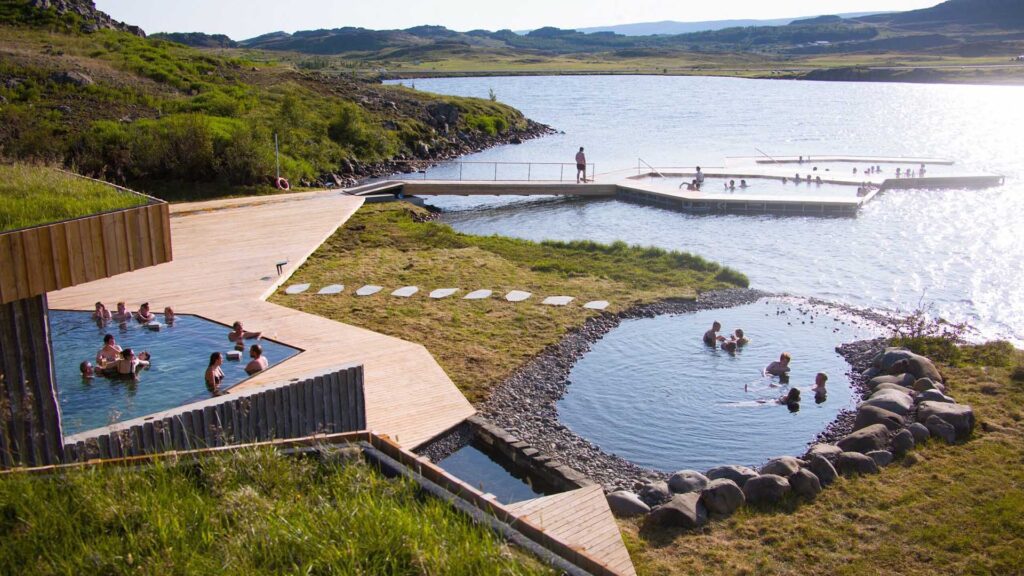
Vök Baths, a geothermal spa on Lake Urriðavatn, features floating infinity pools filled with naturally warm, mineral-rich water. Unlike most Icelandic hot springs, its geothermal water is drinkable, adding a unique touch. The baths offer steam rooms, hot pools, and a cold plunge, all with scenic lake views. The on-site café serves locally sourced food and herbal tea brewed from the same geothermal water. Less crowded than the Blue Lagoon, Vök is a perfect place to relax after exploring East Iceland, especially in the evening when the pools reflect the soft northern light.
Borgarfjörður Eystri
Borgarfjörður Eystri is one of the most remote but rewarding places to visit in East Iceland. The village is best known for its incredible hiking trails and one of the most accessible puffin colonies in Iceland. It sits in a fjord surrounded by mountains and is rich in folklore, especially stories about elves, with the area believed to be home to Álfaborg, the “City of the Elves.” The region’s dramatic landscapes, colourful mountains, and the unique Stórurð area make it a dream destination for outdoor lovers.
Puffin watching at Hafnarhólmi

A small island near the harbour in Borgarfjörður Eystri, Hafnarhólmi is one of the best places in Iceland to see puffins up close. Thousands of puffins nest here every summer, and a well-built viewing platform allows visitors to observe them without disturbing their habitat. The site is also home to other seabirds, including kittiwakes and fulmars. The area is easily accessible, making it a great stop for birdwatchers and photographers.
Hiking paradise

Borgarfjörður Eystri is known for its extensive hiking trails, particularly the Víknaslóðir network, also called the “Trails of the Inlets.” These routes connect abandoned fjord settlements and pass through colourful mountains, lush valleys, and dramatic coastlines. The trails range from short walks to multi-day treks, offering a variety of landscapes and opportunities to explore Iceland’s untouched wilderness.
Stórurð

A remote hiking destination featuring a landscape of massive boulders, turquoise ponds, and green meadows. The hike to Stórurð takes about 3–4 hours round trip, with the trail leading through scenic valleys before reaching the surreal rock formations. The pools of bright blue water between the boulders make this one of the most unique and visually striking areas in East Iceland.
Local charm & folklore
The village of Borgarfjörður Eystri has a deep connection to Icelandic folklore, particularly stories about elves. Álfaborg, a rocky hill near the town, is said to be the home of the “elf queen,” and many locals embrace these traditions. The village also has a strong artistic and handicraft community, with local workshops and small galleries showcasing handmade goods, paintings, and wool products. Storytelling and cultural heritage play an important role in the town’s identity, making it a fascinating place to experience Icelandic traditions.
West Iceland
Borgarnes
Borgarnes is a small but historically rich town, located on a peninsula with great views over the sea. Its strong connections to Icelandic sagas, particularly Egill’s Saga, make it well known. The saga tells the story of the Viking warrior poet Egill Skallagrímsson. The town’s Settlement Centre is a great place to learn about Iceland’s Viking history, and its location makes it a convenient base for exploring Borgarfjörður, an area rich in hot springs, lava fields, and waterfalls.
Settlement Centre Museum
Located in the heart of Borgarnes, the Settlement Centre Museum offers an engaging introduction to Iceland’s Viking history and early settlers. The museum features two interactive exhibitions: one covering the story of Iceland’s first Norse settlers and another focusing on Egill’s Saga, which tells the tale of Egill Skallagrímsson, a Viking warrior, poet, and farmer who lived in the area. The exhibits use audioguides, animated displays, and dramatic storytelling, making it accessible and interesting for all ages. The museum also has a restaurant and gift shop, making it a great stop for history lovers and families travelling through West Iceland.
Borgarbyggð Swimming Pool

A modern geothermal swimming pool in Borgarnes offers a relaxing and family-friendly atmosphere. The facility includes hot tubs, a steam room, a sauna, and a large waterslide, making it a great place for relaxation and fun. The naturally heated water comes from local geothermal sources, providing a soothing and warm experience year-round. With indoor and outdoor pools, visitors can enjoy the facility in any season, whether it’s a refreshing summer swim or a cosy soak under the northern lights in winter.
Hafnarfjall Mountain

A prominent mountain just south of Borgarnes, Hafnarfjall offers a short but rewarding hike with expansive views over the Borgarfjörður region and nearby fjords. The climb takes about 1.5 to 2 hours round-trip, depending on conditions and experience level. While the trail can be steep and exposed to strong winds, the summit rewards hikers with stunning panoramic views of the coastline, lava fields, and Snæfellsnes Peninsula on clear days.
Hraunfossar & Barnafoss Waterfalls

Located about an hour’s drive from Borgarnes, these two waterfalls offer a striking contrast in appearance and movement. Hraunfossar is a series of small waterfalls that emerge beneath a lava field, creating a delicate, cascading effect over mossy rocks. In contrast, Barnafoss is a fast-moving, powerful waterfall rushing through a narrow canyon with a deep blue colour. Barnafoss (“Children’s Falls”) comes from a local legend about two children who fell into the river. The area features well-maintained walking paths and viewing platforms, making exploring both falls in one visit easy.
Deildartunguhver
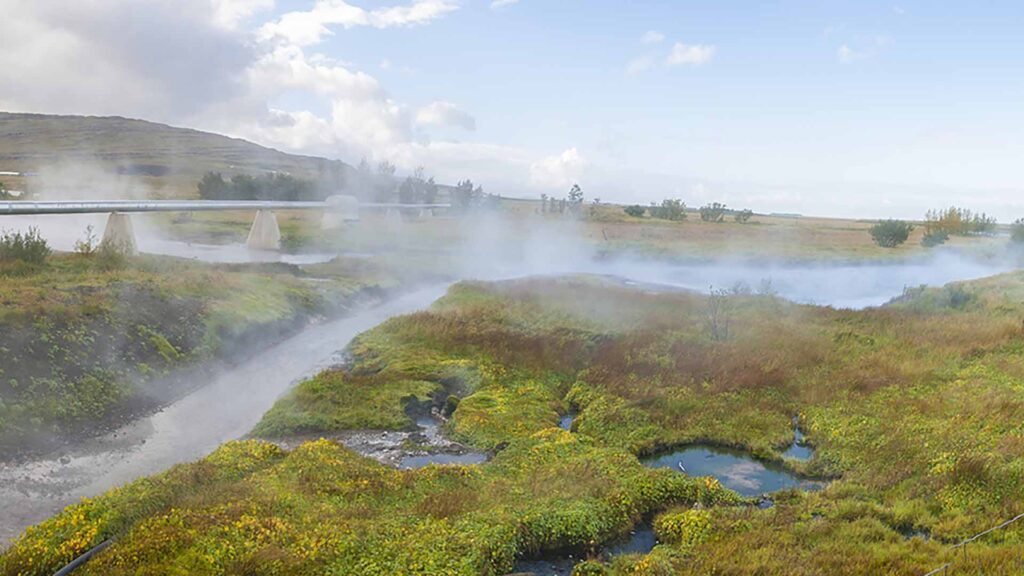
Recognized as the most powerful hot spring in Europe, Deildartunguhver releases boiling geothermal water at 180 litres per second. The spring is so powerful that it supplies hot water for homes and businesses in nearby towns like Borgarnes and Akranes, piped over long distances. Though the water is too hot for bathing, visitors can safely view the steaming, bubbling springs from designated walkways. A nearby geothermal greenhouse grows vegetables using the heat from the spring, and the area is home to Krauma Spa, where visitors can experience natural hot spring water mixed with cold glacial runoff for a relaxing geothermal bath.
Stykkishólmur
Stykkishólmur is one of Iceland’s most picturesque fishing towns on the Snæfellsnes Peninsula’s northern coast. With its brightly coloured houses, charming harbour, and a strong focus on sustainability, it is a favourite stop for travellers exploring the area. The town is also the gateway to Breiðafjörður Bay, filled with small islands, birdlife, and dramatic coastal scenery.
Súgandisey Cliff
A small hill near the harbour in Stykkishólmur, offering panoramic views over the town, Breiðafjörður Bay, and its scattered islands. The short and easy hike takes just a few minutes but provides an excellent vantage point for photography, especially at sunset. At the top, you’ll find a historic red lighthouse, adding to the location’s charm. The area is also known for birdwatching, as seabirds frequently nest along the nearby cliffs.
Norwegian House

A historic wooden building from 1832, originally constructed by Norwegian merchants and now home to a museum showcasing traditional Icelandic craftsmanship. The house is one of the oldest in Stykkishólmur, preserved with authentic 19th-century furniture, textiles, and household items. Visitors can explore exhibits on Iceland’s trade history, the lifestyle of early settlers, and locally made crafts, such as wool products and carved wooden tools. The museum also hosts temporary art and cultural exhibitions throughout the year.
Boat Tours on Breiðafjörður Bay
A popular way to explore the wildlife-rich waters surrounding Stykkishólmur, these tours offer the chance to see puffins, white-tailed eagles, seals, and other seabirds. Many tours navigate around the countless small islands in the bay, some of which have historic ruins or unique geological formations. A highlight of some boat trips is the shellfish sampling experience, where guides pull up fresh scallops and sea urchins from the ocean, allowing passengers to taste them on the spot.
Ferry to Flatey Island

A peaceful, car-free island in Breiðafjörður Bay, accessible by ferry from Stykkishólmur. Flatey is known for its historic charm, colourful houses, and rich birdlife, with puffins and Arctic terns nesting in summer. The island has a small year-round population, but in summer, visitors can stay in guesthouses and enjoy hiking trails, old farm ruins, and the unique atmosphere of this remote settlement. Flatey also has Iceland’s oldest and smallest library, housed in a historic church building.
Grundarfjörður
Grundarfjörður is a small fishing town best known as the home of Kirkjufell, one of the most photographed mountains in Iceland. With its distinctive peak and nearby Kirkjufellsfoss waterfall, the area has become a major stop for photographers and nature lovers. Beyond its famous mountain, Grundarfjörður also offers whale watching, Viking history, and access to the Snæfellsnes Peninsula’s best sights.
Kirkjufell & Kirkjufellsfoss

One of Iceland’s most photographed landmarks, Kirkjufell is a distinctive, cone-shaped mountain rising 463 metres above the coastline. Its striking symmetry makes it a favourite for photographers, especially when framed with Kirkjufellsfoss, a small but scenic waterfall nearby. The area is particularly beautiful in winter when the mountain is covered in snow, and in summer when the surrounding fields turn green. Kirkjufell gained international fame after appearing in Game of Thrones as the “Arrowhead Mountain”, making it a must-visit stop for fans of the series.
Whale Watching
Grundarfjörður’s location on Breiðafjörður Bay makes it a great spot for whale-watching tours, with opportunities to see orcas, humpback whales, minke whales, and white-beaked dolphins. Orcas are particularly common in winter and early spring when they follow the movements of herring shoals in the fjord. Many boat tours also include a scenic cruise along the coastline, where visitors can spot puffins and seabirds nesting on cliffs. The bay’s calm waters provide excellent conditions for wildlife viewing, making it one of the best places in Iceland to see marine life up close.
Snæfellsjökull National Park
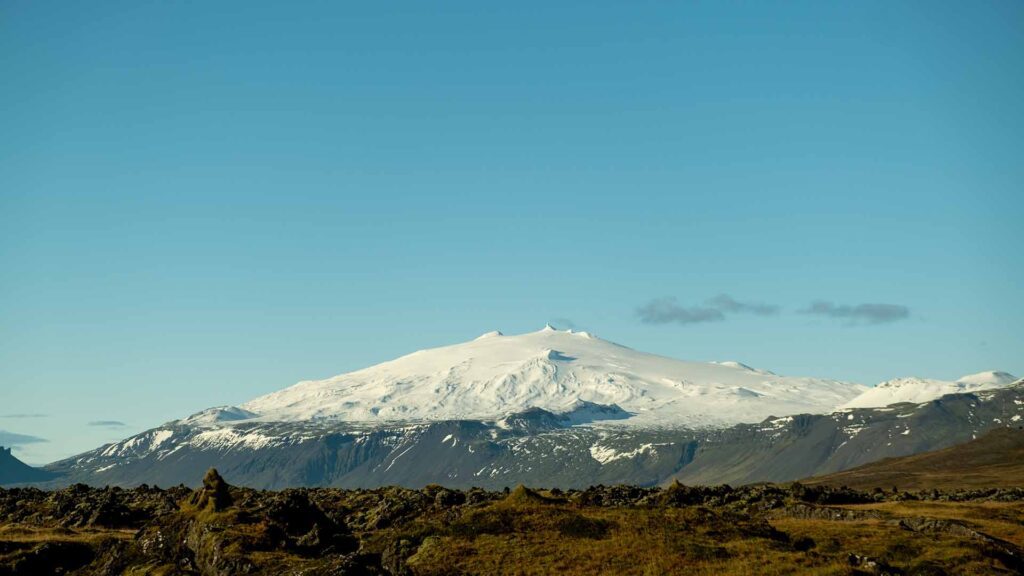
Snæfellsjökull National Park spans the western tip of the Snæfellsnes Peninsula, with Snæfellsjökull, a glacier-covered volcano, rising 1,446 metres above sea level at its centre. Lava fields, black sand beaches, sea cliffs, and caves shape the park’s diverse landscape, offering excellent opportunities for hiking and exploration. Jules Verne’s Journey to the Centre of the Earth made the volcano famous by imagining it as the gateway to a subterranean world. Many locals believe the area holds mystical energy and hidden forces, adding to its intrigue.
Skarðsvík Beach

A rare golden sand beach in Iceland, located on the northwestern tip of the Snæfellsnes Peninsula. Unlike the black sand beaches found elsewhere in Iceland, Skarðsvík’s golden-yellow sand makes it stand out in a country dominated by volcanic landscapes. The beach is surrounded by dark lava formations, creating a unique contrast between the sand and the rugged coastline. Although the waters here can be rough and unsafe for swimming, Skarðsvík is a great place for a scenic walk, photography, and enjoying the peaceful atmosphere away from tourist crowds.
Viking History
Grundarfjörður has strong ties to Icelandic sagas, particularly the Eyrbyggja Saga, which describes early Viking settlements in the area. The region played a key role in Iceland’s medieval trade routes, with Norse settlers using the nearby fjords for fishing and commerce. Archaeological discoveries have uncovered Viking-era structures in the area, giving insight into the lives of Iceland’s earliest inhabitants. Modern-day Grundarfjörður continues to celebrate its heritage with Viking-themed events, and visitors can explore historical sites and folklore connected to the sagas.
South Iceland
Vík í Mýrdal
Vík í Mýrdal, often just called Vík, is the southernmost town in Iceland and a popular stop for travellers exploring the South Coast. Despite its small size, it sits next to some of the country’s most dramatic natural landmarks. The nearby Reynisfjara black sand beach, with its towering basalt sea stacks known as Reynisdrangar, is one of Iceland’s most famous coastal sights. Vík is also known for its abundant birdlife, especially puffins, which nest in the cliffs during the summer.
Reynisfjara Beach
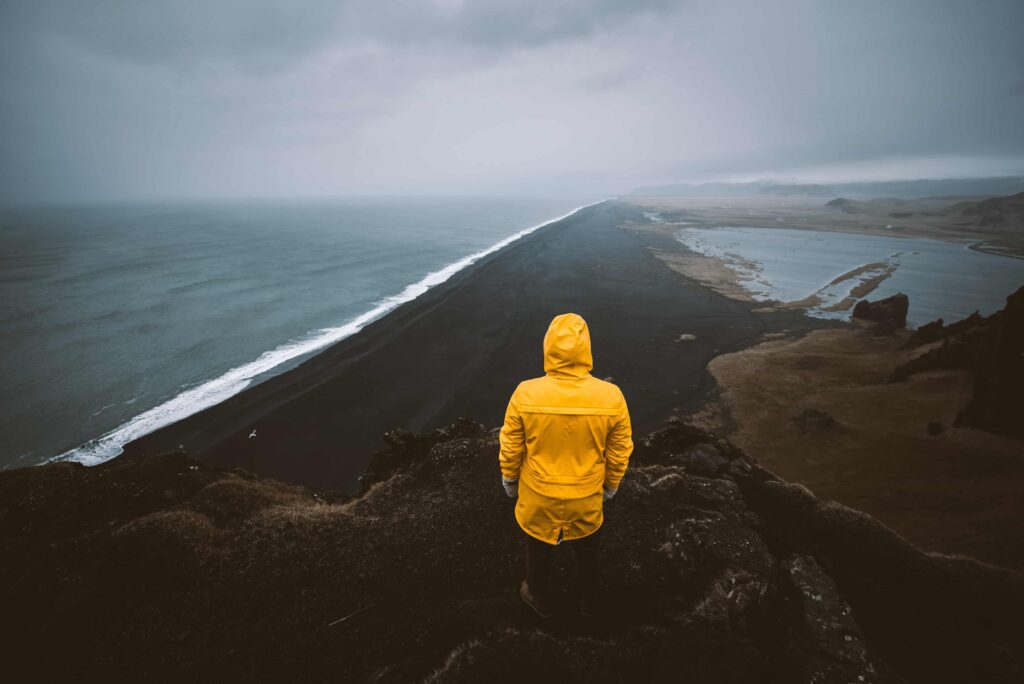
Reynisfjara, one of Iceland’s most famous black sand beaches, features towering basalt columns, powerful waves, and dramatic sea stacks. According to Icelandic folklore, trolls turned to stone formed the Reynisdrangar rock formations just offshore. The beach’s massive hexagonal basalt columns create a giant staircase-like appearance, similar to those at Giant’s Causeway in Ireland. The unpredictable sneaker waves make caution essential, and visitors should always stay well away from the water’s edge.
Dyrhólaey
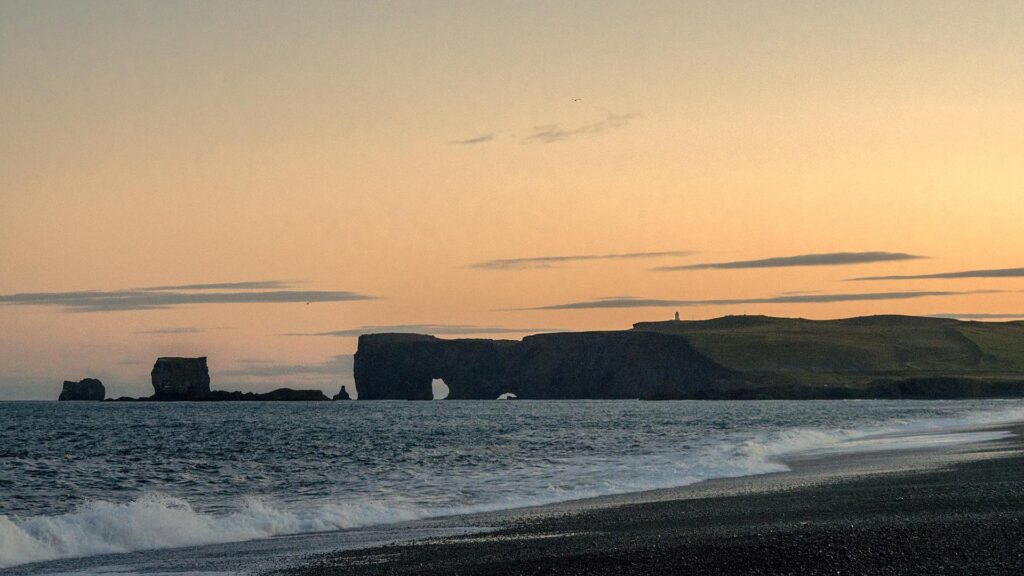
Dyrhólaey is one of the best viewpoints on Iceland’s South Coast, a steep coastal cliff with a massive rock arch. You get panoramic views of Reynisfjara Beach, the vast Atlantic Ocean, and distant glaciers from the top. The name Dyrhólaey means “door hill island”, referring to the large arch-shaped rock formation boats can sail through when the tide allows. The area is also one of Iceland’s best spots to see puffins in summer, as the grassy cliffs provide ideal nesting grounds. Due to the birdlife, parts of Dyrhólaey may be closed during the breeding season from May to June.
Vík Church (Vík í Mýrdal Kirkja)

Perched on a hill above Vík, this small white church with a red roof is one of the most recognisable landmarks in the town. The church offers incredible views over Vík, Reynisfjara Beach, and the surrounding mountains. Built in 1934, it is a typical Icelandic countryside church, simple yet elegant in design. The church serves as a safe assembly point in case of an eruption from Katla, the powerful volcano beneath Mýrdalsjökull Glacier. For visitors, it is an excellent photography spot, especially at sunrise or sunset when the town and coastline are bathed in soft light.
Katla Ice Cave
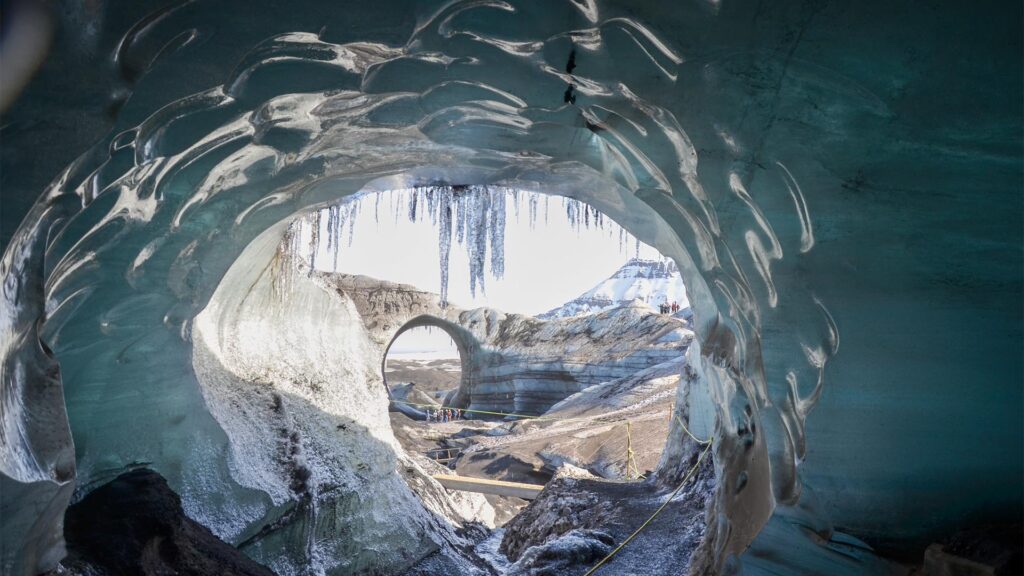
A natural ice cave formed by the active Katla volcano, located under Mýrdalsjökull Glacier. Unlike other seasonal ice caves in Iceland, the Katla Ice Cave is accessible year-round, as the glacier’s movement constantly reshapes it. The cave is known for its black volcanic ash layers trapped in the ice, creating a striking contrast of blue, white, and black ice formations. To visit the cave, you must join a guided tour, which includes a super jeep ride across the glacier’s edge, before exploring the surreal interior. It’s a unique way to experience glacial landscapes and Iceland’s volcanic activity up close.
Mýrdalsjökull Glacier
A massive ice cap covering around 595 km², Mýrdalsjökull is Iceland’s fourth-largest glacier and sits above Katla, one of the country’s most active and powerful volcanoes. The glacier offers exciting outdoor activities, including snowmobiling, glacier hiking, and ice climbing, with guided tours departing from Vík and nearby areas. Mýrdalsjökull is constantly changing due to volcanic activity beneath the ice, and the glacier’s outlets, like Sólheimajökull, provide easier access for glacier walks. Because of its unstable conditions, visitors must always join guided tours for safety when exploring the glacier.
Selfoss
Selfoss is the largest town in South Iceland, known for its riverside charm, geothermal activity, and growing food scene. While historically a transit town, Selfoss has transformed in recent years, with the opening of the Mathöll Food Hall featuring local specialities and international cuisine. Its location makes it an ideal base for visiting the Golden Circle, the South Coast, and the Þjórsárdalur Valley.
Mathöll Selfoss
A modern food hall in the heart of Selfoss, offering a mix of Icelandic and international cuisine. Opened as part of the town’s recent waterfront redevelopment, Mjólkurbúið features a variety of food stalls and restaurants, serving everything from local lamb and fresh seafood to international street food and artisan coffee. The atmosphere is lively, with indoor and outdoor seating overlooking the Ölfusá River. It’s a great place to stop for a meal while exploring South Iceland, offering both traditional Icelandic dishes and contemporary flavours.
Ölfusá River

Iceland’s largest river by volume, the Ölfusá River flows through Selfoss and is a scenic spot for walking, birdwatching, and photography. A riverside path runs along the waterfront, providing a peaceful place to enjoy the views. The river is famous for salmon fishing, and visitors may see fishermen casting their lines in summer. The Selfoss Bridge, originally built in 1891 and reconstructed in 1945, is a historic landmark that connects the two sides of the town, offering great photo opportunities, especially at sunset.
The Bobby Fischer Center
The Bobby Fischer Center in Selfoss honours the chess grandmaster Bobby Fischer, best known for defeating Boris Spassky in the 1972 World Chess Championship. The museum showcases memorabilia, including photographs, newspaper clippings, and books about his career and time in Iceland. Iceland granted Fischer citizenship in 2005 and lived there until his passing in 2008. His grave lies in Laugardælir, just outside Selfoss. The centre provides insight into his legacy, complex personality, and connection to Iceland, making it a worthwhile stop for chess enthusiasts.
Kerið Crater

Kerið, a volcanic crater lake about 15 km from Selfoss, features striking red and green slopes that contrast with the deep blue water inside the crater. A magma chamber collapse following an eruption formed the crater approximately 3,000 years ago. A short walking path circles the rim, providing panoramic views, while stairs lead down to the water’s edge. Unlike many of Iceland’s natural sites, Kerið requires a small entrance fee to support conservation efforts.
Close to the Golden Circle
Selfoss is an ideal base for exploring the Golden Circle, as it is just a short drive from some of Iceland’s most famous attractions. Geysir Geothermal Area, home to the active Strokkur geyser, is about 50 minutes away, while Gullfoss, one of Iceland’s most impressive waterfalls, is around an hour’s drive. Thingvellir National Park, a UNESCO World Heritage Site where Iceland’s parliament was founded in 930 AD, is also easily accessible. This central location makes Selfoss a convenient stop for those exploring South Iceland.
Hveragerði
People often call Hveragerði the “Hot Spring Town” because of its abundant geothermal activity, with steam rising from the ground. Sitting on the Hengill volcanic system, the town offers some of Iceland’s best natural hot springs. Locals also use the underground heat to grow vegetables and even bananas in geothermal greenhouses, making Hveragerði a unique hub for sustainable agriculture.
Reykjadalur Hot Spring River

A scenic geothermal valley near Hveragerði, known for its naturally warm river where visitors can bathe in a natural hot spring setting. The moderate hike to Reykjadalur takes about an hour each way, following a well-marked trail through steaming geothermal fields, bubbling mud pots, and rolling green hills. Once at the river, wooden walkways and small pools allow visitors to relax in the geothermal-heated water while enjoying the mountain views. The best time to visit is early morning or late evening to avoid crowds, and while the river stays warm year-round, the hike can be icy and challenging in winter.
Geothermal Park
A small but fascinating geothermal area in the town of Hveragerði, where visitors can see bubbling mud pools, steaming vents, and geothermal springs up close. The park is unique because of its high geothermal activity directly within the town, which is a rare sight in Iceland. Visitors can boil eggs in a hot spring, explore mineral-rich steam vents, or even try a geothermal foot bath. Guided tours provide insight into Iceland’s volcanic forces, and the site is a great introduction to Iceland’s geothermal energy before heading to larger hot spring areas like Geysir.
Hveragerði Greenhouses
Thanks to its abundant geothermal energy, Hveragerði is one of Iceland’s leading hubs for greenhouse farming, growing vegetables, flowers, and tropical fruits like bananas. The town’s farms use naturally heated water and artificial lighting to create a climate where plants can grow year-round. Some greenhouses are open for tours, where visitors can learn about sustainable Icelandic agriculture, see rows of tomatoes and cucumbers, and even taste geothermal-baked bread. The greenhouses supply fresh produce to restaurants in the region, making it one of the best places in Iceland to try locally grown food.
Lava Tunnel (Raufarhólshellir)

A spectacular lava cave about 30 minutes from Hveragerði formed during a volcanic eruption about 5,200 years ago. Stretching nearly 1.3 km, the tunnel is filled with colourful rock formations, lava stalactites, and massive chambers shaped by ancient lava flows. Guided tours lead visitors through the cave, explaining how lava tubes form and how volcanic activity has shaped Iceland’s landscapes. In winter, ice sculptures and frozen formations appear inside the tunnel, adding to its beauty. Due to uneven terrain and low lighting, tours provide helmets, headlamps, and safety gear for exploration.
Icelandic Horse Riding
Hveragerði is one of the best places in Iceland for horse riding. Tours take riders through geothermal valleys, lava fields, and scenic meadows. The Icelandic horse, small but strong, is known for its smooth tölt gait, making it easy to ride on rough terrain. Tours suit all experience levels, from short beginner-friendly rides to longer treks into the mountains. The landscapes offer a beautiful setting, with routes passing steaming hot springs or lush green valleys in summer.
Höfn
Höfn is a small but charming coastal town in southeast Iceland, best known for its connection to the nearby Vatnajökull Glacier, the largest glacier in Europe. Iceland’s langoustine capital also serves some of the country’s best seafood. Höfn is a great base for visiting glacier lagoons, black sand beaches, and mountain ranges, making it one of the most scenic towns in Iceland.
Jökulsárlón Glacier Lagoon

This large glacial lagoon ranks among Iceland’s most stunning natural wonders. Massive icebergs, broken off from the Breiðamerkurjökull glacier, float in its deep blue waters. The icebergs, some crystal clear and others streaked with volcanic ash, create a striking contrast against the lagoon. Visitors can take boat tours to get closer to the icebergs and occasionally spot seals swimming in the lagoon. Located just an hour from Höfn, Jökulsárlón is a must-visit stop along Iceland’s southeast coast.
Diamond Beach

A black sand beach is next to Jökulsárlón, where glacial ice chunks from the lagoon wash up on the shore, glistening like diamonds in the sunlight. The ice varies in size, shape, and transparency, creating ever-changing sculptures scattered across the beach. Some ice chunks are crystal clear, while others have deep blue hues caused by compressed air bubbles trapped within. The contrast between the bright ice formations and the dark volcanic sand makes this one of Iceland’s most unique and photogenic beaches.
Vatnajökull National Park

Covering 14% of Iceland, this is one of Europe’s largest national parks, featuring glaciers, volcanoes, waterfalls, and rugged mountains. It serves as a gateway to glacier hikes, ice cave tours, and mountaineering, with trails leading to breathtaking viewpoints. The park includes Hvannadalshnúkur, Iceland’s highest peak, and Svartifoss, a waterfall framed by hexagonal basalt columns. In winter, guided tours take visitors inside Vatnajökull’s ice caves, where the ice forms stunning blue tunnels and chambers.
Langoustine (Icelandic lobster)
Höfn is known as the langoustine capital of Iceland and is famous for its fresh, locally caught Icelandic lobster. Langoustine, smaller and sweeter than traditional lobster, is served in various ways, including grilled, pan-fried, or creamy bisque. One of the best places to try this delicacy is Humarhöfnin, a well-known seafood restaurant in Höfn. Many restaurants in the area specialize in fresh seafood straight from the Atlantic, making this one of the best places in Iceland for a seafood feast.
Vestrahorn Mountain (Stokksnes Beach)

One of Iceland’s most dramatic and photogenic landscapes, Vestrahorn is a steep, jagged mountain range that rises directly from the black sand beaches of Stokksnes. The contrast between the dark dunes, reflective tidal flats, and sharp peaks makes this area a photographer’s favourite. Vestrahorn is often surrounded by low-hanging mist or covered in snow, adding to its mystical atmosphere. The area is also home to a replica Viking village, initially built for a film production, which visitors can explore. With fewer crowds than Iceland’s more famous sights, Vestrahorn offers a wild and remote feel perfect for those seeking dramatic coastal scenery.
North Iceland
Akureyri
Akureyri is Iceland’s second-largest urban area and the “Capital of the North,” offering a mix of culture, adventure, and nature. Situated on the shores of Eyjafjörður, Iceland’s longest fjord, Akureyri is known for its mild climate (by Icelandic standards!), vibrant arts scene, and excellent skiing opportunities. The town is also a gateway to Iceland’s most spectacular natural wonders, including Goðafoss waterfall, Mývatn, and whale-watching areas.
Akureyri Church (Akureyrarkirkja)

A well-known landmark in Akureyri, this church stands on a hill overlooking the town and features a distinctive design by Guðjón Samúelsson, the architect behind Hallgrímskirkja in Reykjavík. The church’s interior includes a large pipe organ and beautiful stained glass windows depicting Icelandic history and Christianity. It is a popular place for visitors to admire the architecture, enjoy the views over Eyjafjörður, or attend a concert, as the acoustics inside the church are excellent.
Whale Watching in Eyjafjörður
The waters around Akureyri are among the best in Iceland for spotting marine life, particularly humpback whales, blue whales, and dolphins. The calm, deep fjord provides an ideal feeding ground, leading to frequent and close-up sightings. Tours operate year-round, with summer being the most active season. Winter tours offer a unique whale-watching experience against a backdrop of snow-covered mountains. Some companies also offer silent, eco-friendly tours on electric boats for a quieter, more sustainable way to see the wildlife.
Hlíðarfjall Ski Resort
Akureyri’s main ski resort is considered one of the best places in Iceland for skiing and snowboarding. It has well-maintained slopes, various runs for different skill levels, and modern lifts. The resort is known for having stable winter conditions, often with excellent powder snow, and the views over Eyjafjörður from the slopes are spectacular. It is a popular destination for locals and visitors, offering a great winter sports experience just a short drive from the town center.
Lystigarður Akureyrar (Botanical Gardens)

Located in the heart of Akureyri, this botanical garden is a unique attraction in Iceland, featuring thousands of plant species worldwide, including many that are rare to find growing so far north. The garden is both a research centre and a public park, with walking paths, ponds, and flower beds that make it a peaceful place to explore. The gardens are in full bloom in summer, offering a colourful contrast to the surrounding northern landscapes.
Christmas House (Jólahúsið)

Just outside Akureyri, the Christmas House celebrates holiday traditions year-round. Inside, visitors browse decorations, gifts, and Icelandic Christmas-themed items, including those linked to the country’s folklore, such as the Yule Lads and the Christmas Cat. The building’s exterior features gingerbread-like trim, and a small tower plays Christmas music. Families and holiday enthusiasts enjoy this festive stop, no matter the season.
Húsavík
People often call Húsavík the Whale Watching Capital of Iceland because it offers the highest chance of spotting whales in Icelandic waters. The town’s picturesque harbour, lined with colourful buildings, creates a charming setting, while its relaxed atmosphere makes it a great stop on any Diamond Circle itinerary. Húsavík gained global recognition after appearing in the film Eurovision Song Contest: The Story of Fire Saga.
Whale Watching Tours

Húsavík is known as one of the best places in Iceland for whale watching, with regular tours offering high chances of seeing humpback whales, minke whales, and sometimes even blue whales. The nutrient-rich waters of Skjálfandi Bay attract marine life, making sightings frequent and often close to the boats. Many tours use traditional oak boats or quiet electric boats for a more sustainable experience. Summer offers the best opportunities, but tours run into autumn and winter, providing a different perspective of the bay’s wildlife.
Húsavík Whale Museum
This museum provides an in-depth look at whales, their biology, and conservation efforts in Iceland and beyond. The exhibits include full-scale whale skeletons, interactive displays, and information on different species found in Icelandic waters. The museum also highlights the history of whaling and modern efforts to protect marine life. Located near the harbor, it is a great stop before or after a whale-watching tour to learn more about the animals seen on the trip.
GeoSea Geothermal Sea Baths

A unique geothermal spa that uses naturally heated seawater instead of freshwater. The pools are located on a cliffside overlooking Skjálfandi Bay, offering panoramic views of the ocean and, on clear days, the Arctic Circle in the distance. The mineral-rich seawater is believed to have skin-healing properties, and the lack of added chemicals makes it a natural and soothing experience. Unlike many hot springs in Iceland, GeoSea stays open late, making it a great place to relax under the midnight sun in summer or watch the northern lights in winter.
Húsavíkurkirkja (Húsavík Church)

Built in 1907, a picturesque wooden church stands in the centre of Húsavík. Designed in a Norwegian style, it features a steep roof, wooden interior details, and stained glass windows. Many consider it one of Iceland’s most beautiful churches, and its location near the harbour makes it a notable town landmark. The church also hosts concerts and community events, adding to its cultural significance.
Ásbyrgi Canyon (Nearby)

A massive horseshoe-shaped canyon located about an hour’s drive from Húsavík. According to Norse mythology, it was formed by the hoofprint of Sleipnir, Odin’s eight-legged horse. The canyon is part of Vatnajökull National Park and is filled with lush vegetation, birch trees, and a small lake at its base. Hiking trails lead to viewpoints overlooking the cliffs, which rise up to 100 meters high. It is a quiet and scenic area, contrasting the volcanic landscapes found elsewhere in Iceland.
Siglufjörður
Siglufjörður is one of Iceland’s most scenic fjord towns, known for its herring fishing heritage, colourful houses, and remote beauty. Once the centre of Iceland’s booming herring industry, Siglufjörður now offers visitors a unique look into this history while also providing great opportunities for hiking, skiing, and fjord exploration.
Herring Era Museum

A museum dedicated to Iceland’s herring industry, which played a crucial role in the country’s economy during the early to mid-20th century. The exhibits include restored fishing boats, processing equipment, and interactive displays showcasing fishermen’s and factory workers’ daily lives during the herring boom. Visitors can explore old salting stations, listen to stories from former workers, and watch historical footage of the industry at its peak. The museum brings this fascinating chapter of Icelandic history to life and is considered one of the best heritage museums in the country.
Hiking Trails
Siglufjörður is surrounded by mountains and fjords, making it an excellent base for hiking. Trails range from short walks with scenic viewpoints to more challenging treks over mountain passes. A notable route connects Siglufjörður to nearby Héðinsfjörður, offering breathtaking views of the fjords and the North Atlantic. Other trails lead to abandoned farms, secluded valleys, and hidden waterfalls, providing a mix of history and nature. Summer is the best time for hiking, as the trails are free from snow and the wildflowers are in bloom.
Colourful Harbourfront

The town’s waterfront is lined with historic fishing buildings painted in bright colours, giving Siglufjörður a charming and inviting atmosphere. The harbour is a great place for photography, with reflections of the boats and surrounding mountains creating a picturesque setting. Several cafés and restaurants overlook the water, offering fresh seafood and local specialities in a peaceful environment. It’s an ideal spot to relax and take in the slower pace of life in this northern fishing village.
Dalvík
Dalvík is a small but lively fishing village with a strong sense of community and amazing access to outdoor adventures. It is famous for its annual fish festival, skiing, and excellent whale-watching tours, often with fewer crowds than Húsavík.
Great Whale Watching
Dalvík offers excellent whale-watching opportunities, similar to Húsavík, but with fewer tourists and a more relaxed atmosphere. Tours from the town frequently encounter humpback whales, white-beaked dolphins, and porpoises, with the possibility of seeing blue whales and orcas. Many tours also include a chance to try sea angling, where visitors can catch fish and have it prepared after the trip. The scenic setting of Eyjafjörður, with its surrounding mountains and calm waters, makes whale watching here a memorable experience.
Skiing at Böggvisstaðafjall

Dalvík is home to one of Iceland’s best small ski resorts, offering well-groomed slopes and breathtaking fjord views. The resort runs for all skill levels, with easy slopes and more challenging terrain for experienced skiers and snowboarders. Böggvisstaðafjall is also a great location for off-piste skiing and backcountry tours, with guides offering access to untouched powder fields in the surrounding mountains. The ski season typically runs from December to April, with excellent snow conditions throughout.
Ferry to Grímsey Island
Dalvík is the departure point for the ferry to Grímsey, Iceland’s northernmost inhabited island and the only part of the country within the Arctic Circle. The ferry ride takes about three hours each way, allowing visitors to spend the day exploring the island’s rugged coastline, bird cliffs, and remote landscapes. Grímsey is known for its large puffin population in summer and its unique location, where visitors can step across the Arctic Circle marker and experience nearly 24 hours of daylight in June.
Local Seafood
Close by in Hauganes, you can get some of Iceland’s best fish. Baccalá Bar is a cozy restaurant in Hauganes, a small village on the west bank of Eyjafjörður Bay in North Iceland, about 25 km from Akureyri and 12 km from Dalvík. Run by Ektafiskur, a bacalao producer since 1940, the restaurant serves a variety of Icelandic dishes with options for all ages.
Westfjords
Ísafjörður
Ísafjörður is the largest town in the Westfjords, surrounded by towering mountains, deep fjords, and untouched wilderness. It is a centre for outdoor activities, history, and great seafood. The town’s small but lively cultural scene makes it an excellent place to experience traditional Icelandic music, festivals, and folklore.
Westfjords Heritage Museum
This museum in Ísafjörður provides a fascinating look at the region’s fishing and maritime history, with exhibits on traditional boat building, fishing techniques, and the daily lives of coastal communities. Housed in a restored 18th-century warehouse, the museum features a collection of old fishing gear, navigational tools, and personal stories from generations of Westfjords fishermen. Visitors can explore hands-on displays, including a fully preserved rowboat, and learn how fishing shaped the culture and economy of the Westfjords.
Hornstrandir Nature Reserve
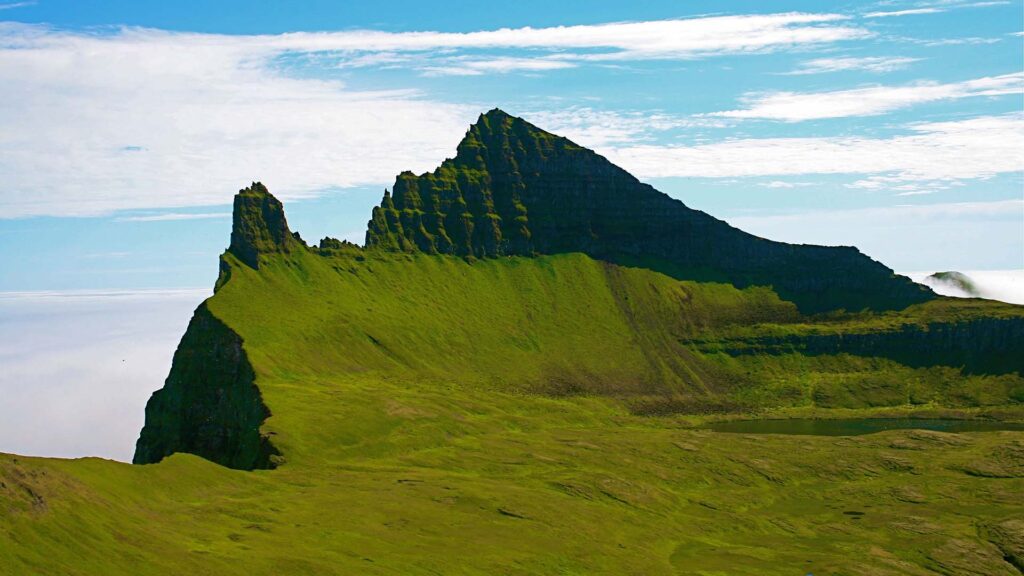
One of the most remote and untouched areas in Iceland, Hornstrandir is a vast wilderness of steep cliffs, deep fjords, and Arctic tundra. Accessible only by boat from Ísafjörður, the reserve is a paradise for multi-day hikers and nature lovers seeking solitude. The area has been uninhabited since the 1950s, allowing wildlife like Arctic foxes and seabirds to thrive. Popular hikes include the route from Hesteyri to Hornvík, where towering cliffs provide one of Iceland’s best birdwatching spots. Due to its isolation, visitors must be self-sufficient and prepared for unpredictable weather.
Fjord Kayaking

The calm waters around Ísafjörður offer excellent conditions for kayaking, with stunning views of the surrounding fjords, mountains, and small fishing villages. Guided tours take paddlers through scenic inlets, past waterfalls and sea cliffs, and sometimes even close to seals and seabirds. More adventurous routes venture into the uninhabited fjords of Hornstrandir, where kayakers can experience complete isolation in Iceland’s wild landscapes. The long summer days provide extended daylight for paddling, making this one of the best ways to explore the Westfjords.
Patreksfjörður
Patreksfjörður is a great base for exploring the Westfjords, offering easy access to some of Iceland’s most breathtaking landscapes, bird cliffs, and hidden beaches. The town is a peaceful place to stay, with a small harbour, great seafood restaurants, and a laid-back atmosphere.
Látrabjarg cliffs

The largest seabird cliffs in Europe, stretching 14 kilometres along the westernmost point of Iceland. These towering cliffs are home to millions of seabirds, including puffins, guillemots, and razorbills, which nest here in the summer. The cliffs provide one of the best places in Iceland to see puffins up close, as they are unafraid of humans and often sit just meters from the edge. The views from the cliffs are spectacular, but visitors should be cautious, as the edges are unstable due to the soft turf and burrowing birds.
Rauðasandur beach

A rare golden and red sand beach in the Westfjords, standing out from Iceland’s more common black sand beaches. The colour of the sand changes with the light and tide, creating a unique contrast against the surrounding mountains and ocean. The area is peaceful and rarely crowded, making it an ideal place for long walks and photography. Seals are often spotted resting on the shoreline, and on clear days, there are views across the bay toward the Látrabjarg cliffs.
Dynjandi waterfall
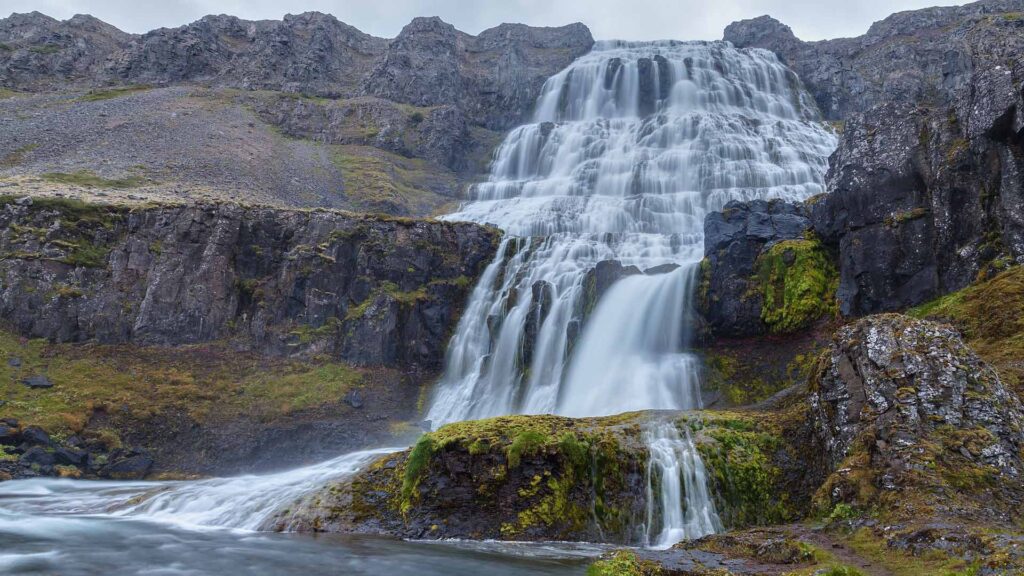
One of the most stunning waterfalls in Iceland, Dynjandi cascades down a series of rocky steps, creating the appearance of a wide, flowing staircase. The main drop is 100 meters high, with several smaller waterfalls below it, forming a scenic series of cascades along the river. A short but steep hiking trail leads from the parking area to the base of the main waterfall, passing by the smaller falls along the way. The rushing water’s sound and the landscape’s scale make Dynjandi one of the most impressive natural sights in the Westfjords.
Steep fjord roads
The drive to Patreksfjörður is an adventure in itself, with winding mountain roads and steep descents leading into the remote fjords. The journey offers some of Iceland’s most scenic coastal views, with towering cliffs, deep valleys, and waterfalls cascading down the hillsides. While the roads are well-maintained in summer, winter travel can be challenging due to snow and ice, making summer the best season for those wanting to explore this part of the Westfjords by car.
Reykjanes Peninsula
Grindavík
Grindavík is a small fishing town on the Reykjanes Peninsula, best known for its proximity to the Blue Lagoon and the region’s active volcanic landscape. Despite being affected by recent volcanic eruptions, the town remains a great stop for travellers exploring geothermal wonders, lava fields, and coastal scenery. Grindavík is also a gateway to the Reykjanes Geopark, where visitors can see the meeting point of the Eurasian and North American tectonic plates.
Blue Lagoon

One of Iceland’s most well-known geothermal spas, the Blue Lagoon is famous for its milky blue, mineral-rich waters. The lagoon is heated naturally by geothermal activity, with temperatures averaging around 38–40°C. The water contains silica and algae, which are believed to have beneficial effects on the skin. Visitors can relax in the warm waters, enjoy in-water treatments, or visit the on-site spa, which offers saunas, steam rooms, and a lava rock relaxation area. Located in a lava field on the Reykjanes Peninsula, it is a short drive from Keflavík Airport, making it a popular stop for travellers.
Brimketill lava pool

A naturally formed rock pool on the edge of the Atlantic Ocean, created by the relentless erosion of lava by the waves. The pool appears inviting, but the waters are rough, and swimming is unsafe. Instead, visitors can admire the view from a nearby viewing platform, where the crashing waves create a dramatic display. The site is especially striking on windy days when the ocean surges against the volcanic rock formations.
Gunnuhver hot springs

The largest active mud pool in Iceland, Gunnuhver, is a highly active geothermal area with bubbling mud pots and thick steam vents rising from the earth. The site is named after a ghost from local folklore, who was said to have been trapped in the hot spring by a priest centuries ago. Wooden walkways allow visitors to get close to the steaming vents while staying safe. Due to the high sulfur content in the air, there is a strong smell, adding to the otherworldly atmosphere of the site.
Fagradalsfjall volcano

One of Iceland’s newest volcanic sites, Fagradalsfjall, erupted in 2021, drawing thousands of visitors to witness fresh lava flows. The volcano has since erupted multiple times, with the most recent activity reshaping the landscape. Hiking trails lead to viewpoints where visitors can see the lava fields and steaming fissures left behind by the eruptions. Conditions change frequently, so checking for trail access and activity updates is recommended before visiting.
Reykjanes lighthouse

The oldest lighthouse in Iceland, built in 1908, is located on a rugged coastal stretch of the Reykjanes Peninsula. The lighthouse stands on a hill overlooking the ocean, providing a great spot for photography and panoramic views. The surrounding area features dramatic cliffs, black sand beaches, and crashing waves, making it an excellent place for sunset viewing. The original lighthouse was destroyed by earthquakes and rebuilt at a safer location further inland.
Keflavík
Keflavík is best known for being home to Iceland’s main international airport, but the town offers coastal charm, Viking history, and unique museums. Many visitors pass through without exploring, but it’s worth a stop, especially if you have time before a flight. Keflavík also forms part of the larger Reykjanesbær area, which includes nearby Njarðvík and Hafnir.
Viking World Museum
A museum dedicated to Iceland’s Viking heritage, featuring a full-sized replica of the Íslendingur, a ship modelled after a historic Viking vessel. The ship was built using traditional techniques and successfully sailed to North America in 2000 to commemorate Leif Erikson’s journey. The museum also includes exhibits on Norse mythology, Viking navigation, and Iceland’s settlement history. Visitors can board the ship, explore interactive displays, and learn about the daily lives of Viking explorers.
The Giantess in the Cave

A unique folklore-inspired attraction in Keflavík featuring a massive troll figure inside a cave by the harbour. The character is based on a children’s book about a friendly giantess who lives by the sea. The cave is designed as her home, with oversized furniture and decorations to match her story. It is a fun stop for families and those interested in Icelandic folklore, adding a whimsical touch to the town’s waterfront.
Stekkjarkot

A small, well-preserved traditional Icelandic turf house that provides insight into how Icelanders lived in past centuries. The structure is built with turf, wood, and stone, designed to insulate against the harsh Icelandic climate. Inside, visitors can see examples of simple furnishings and tools farmers and fishermen use. The house is part of a larger effort to preserve Iceland’s architectural history and offers a glimpse into rural life before modern development.
Duus Museum & Art Gallery
A cultural centre that combines exhibitions on local history with contemporary art displays. The museum is housed in historic buildings once used for trade and fishing, reflecting the maritime heritage of Keflavík and Reykjanesbær. Exhibits cover topics such as Iceland’s fishing industry, early settlement, and the impact of aviation on the region. The art gallery showcases works from Icelandic artists, mixing paintings, sculptures, and photography.
Seaside walking paths

A scenic walkway along Keflavík’s coast offers views of the North Atlantic, rugged lava fields, and distant mountains. The paths with benches and viewpoints are ideal for walking, jogging, or cycling. The fresh sea air and crashing waves make it a peaceful place for a stroll, especially at sunrise or sunset. In clear weather, it is sometimes possible to see across the bay toward the Snæfellsnes Peninsula.
Capital Area
Reykjavík
Reykjavík is Iceland’s capital and largest city, packed with culture, history, nightlife, and stunning architecture. Despite being a capital, Reykjavík retains a small-town feel, with colourful houses, walkable streets, and easy access to nature. The city is the perfect base for exploring Iceland, offering urban attractions and nearby day trips to the Golden Circle, South Coast, and Reykjanes Peninsula.
Hallgrímskirkja
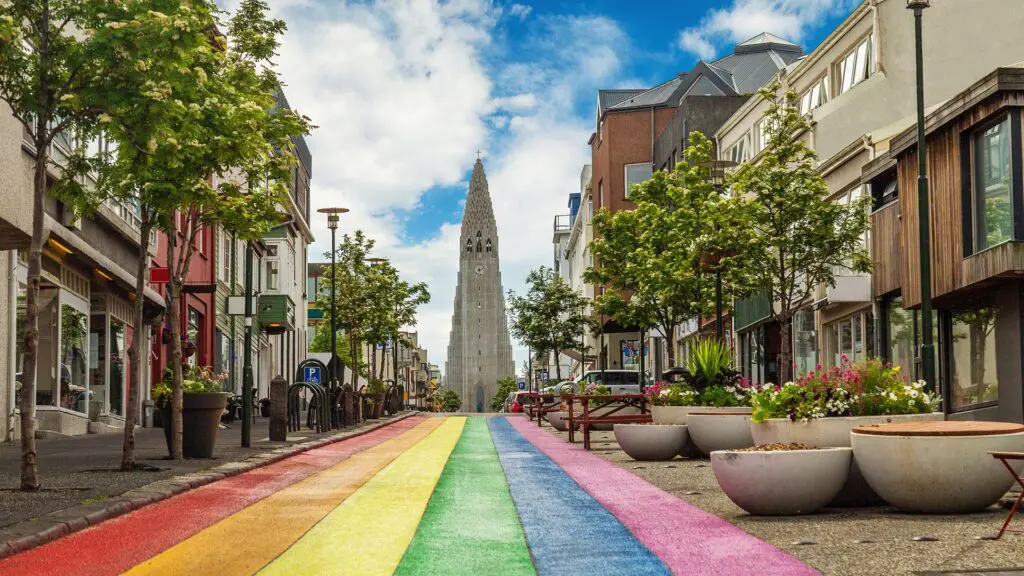
One of Reykjavík’s most recognizable landmarks, this church features a tall, stepped concrete design inspired by Iceland’s basalt columns. Visitors can take an elevator to the top of the tower for panoramic views of the city, the surrounding mountains, and the ocean. The church also houses a large pipe organ, often used for concerts and services.
Harpa Concert Hall

A modern cultural venue is known for its distinctive glass facade, which reflects light in different colours depending on the time of day. Harpa hosts concerts, theatre performances, and art exhibitions, making it a central hub for Reykjavík’s arts scene. The building is a popular spot for photography, both inside and out, due to its striking architecture.
Sun Voyager (Sólfarið)

A steel sculpture on the waterfront resembles a Viking ship but also symbolizes exploration and discovery. Set against the ocean and distant mountains, it is a popular spot for photography, especially at sunrise and sunset.
National Museum of Iceland
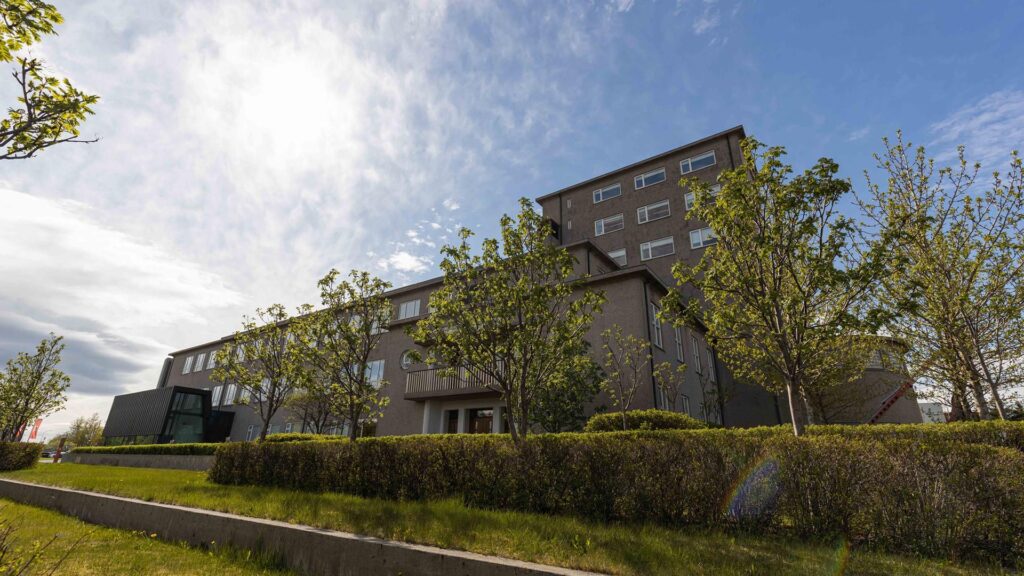
A museum dedicated to Iceland’s history, from the Viking Age to modern times. Exhibits include artefacts such as medieval swords, traditional clothing, and early settlement tools. The museum provides a comprehensive overview of how Iceland developed, covering themes of seafaring, religion, and daily life.
Laugavegur & Skólavörðustígur

Two of Reykjavík’s busiest streets are lined with a mix of independent boutiques, international brands, bars, and restaurants. Laugavegur is known for its shopping and nightlife, while Skólavörðustígur leads up to Hallgrímskirkja and features local art galleries and craft stores. Both streets are great for strolling, dining, and experiencing the city’s urban culture.
Perlan

A glass-domed building on a hill overlooking Reykjavík featuring interactive exhibits about Iceland’s nature and geology. Visitors can walk through an artificial ice cave, learn about glaciers, and explore a planetarium. The top floor has an observation deck offering one of the city’s best views.
Tjörnin Pond
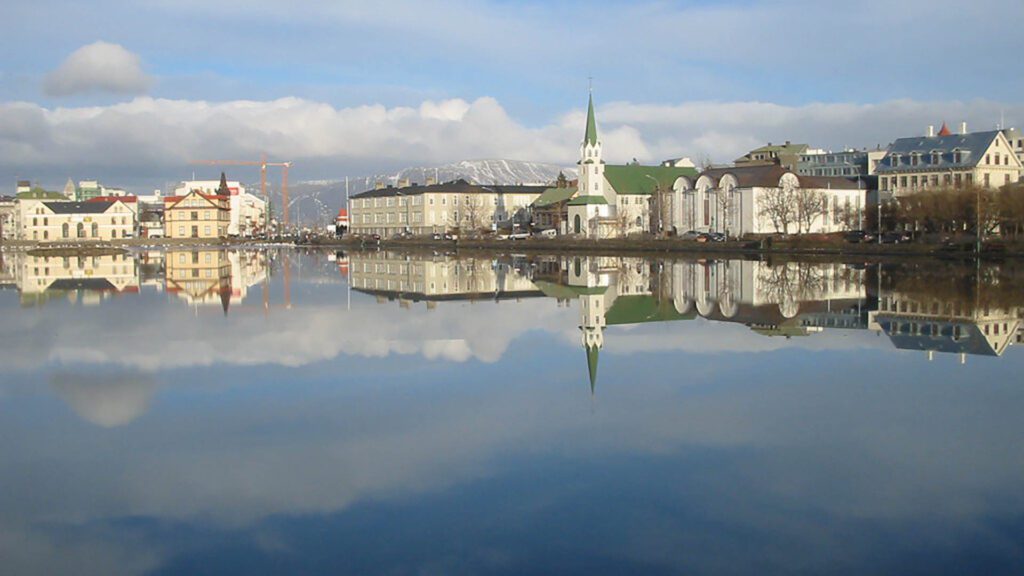
A small lake in the centre of Reykjavík, surrounded by walking paths and historic buildings. It is a popular spot for birdwatching, as many species of ducks, swans, and geese gather here year-round. The Pond often freezes over in winter, and locals use it for ice skating.
Reykjavík’s nightlife
The city has a lively bar and club scene, with venues open late into the night, especially on weekends. Many bars feature live music, DJ sets, or casual social atmospheres. Unlike many cities, Reykjavík’s nightlife is centred in a walkable downtown area, making it easy to hop between different spots.
You can also join our Reykjavik Beer & Booze tour to experience the best our city offers.
Whale-watching & puffin tours

Tours leave from the Old Harbour, offering a chance to see marine wildlife in Faxaflói Bay. Whale-watching tours often spot humpback whales, minke whales, and dolphins, while puffin tours visit nearby islands where the birds nest in summer. Some companies offer silent electric boat tours for a more eco-friendly experience.
Please signup for our newsletter for more fun facts and information about Iceland.
The post Top 20 Towns in Iceland appeared first on Your Friend in Reykjavik.

 vigna
vigna 





